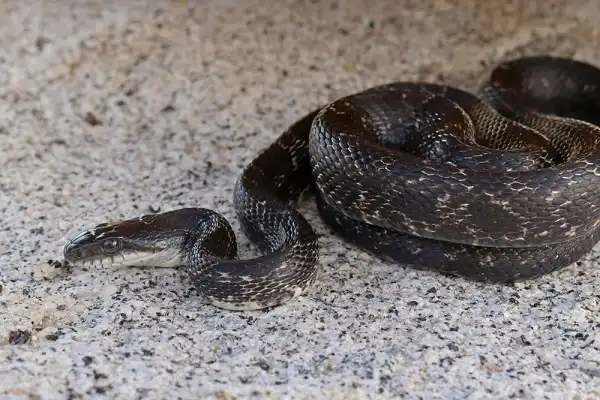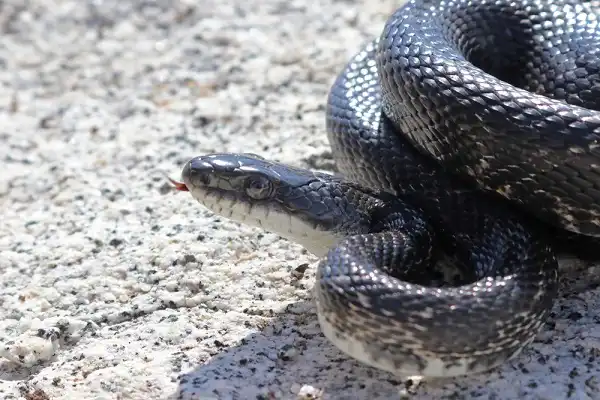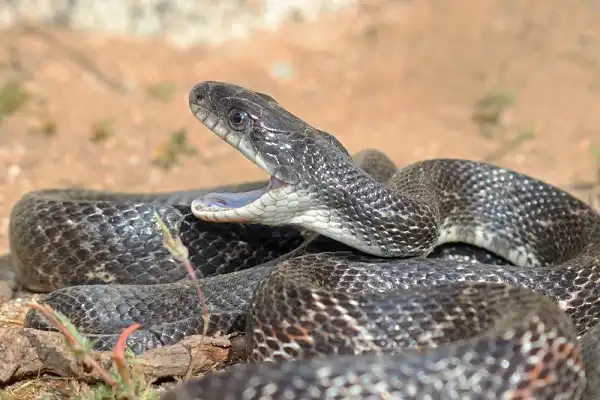Have you ever been outside and noticed a snake slithering around? The Western Rat Snake is a large species of rat snake found in the United States, and it’s an incredible sight to behold! They’re remarkable animals with unique characteristics that make them one of the most interesting snakes out there. From their scales to their diet, exploring these fascinating creatures will leave you nothing short of awestruck. So, come explore this wonderful reptile with us as we delve into the world of the Western Rat Snake!

Western Rat Snake Description
The Western Rat Snake, also known as the Great Plains Rat Snake or the Grey Rat Snake, is a species of rat snake found in the United States. They are one of the largest species of rat snake. Their coloring can vary from grey to brown or black with a variety of patterning on their skin. Western Rat Snakes sport smooth scales with keeled scales running down their backs which are usually divided by two pale stripes. They have large pupils that change color depending on light conditions. These snakes have long tails that make them agile climbers, enabling them to access food sources otherwise out of reach, such as bird nests and other small animals hiding in tree hollows.
Western Rat Snake Habitat
The Western Rat Snake is found in many different habitats across much of the United States, from woodlands and prairies to rivers and streams. They are adaptable snakes who have been known to inhabit both urban and rural areas. Western Rat Snakes prefer open areas but will also take refuge in places with dense vegetation or wood piles for cover. They can often be seen sunning themselves on logs, rocks, stumps, or trees when temperatures are moderate outside. Western Rat Snakes also make their homes near water sources as they require a steady source for drinking and hunting food. In addition to these natural habitats, these reptiles have been known to live in man-made structures such as old houses, barns, sheds, and outbuildings. When threatened by predators or potential danger, Western Rat Snakes will often retreat into tight spaces or hide beneath rocks or other debris. This species is also known to use defensive tactics when cornered such as flattening themselves out and vibrating their tail like a rattlesnake – though no sound is produced – as well as biting aggressively if further provoked.
Western Rat Snake Diet
The Western Rat Snake is a carnivorous species that feeds primarily on rodents, such as mice and rats, as well as small birds and their eggs. They can also take advantage of other animals such as frogs and lizards if the opportunity arises. These snakes are known to be fast and agile hunters who use their long tails to help them scale trees in order to access otherwise inaccessible food sources, such as bird nests. Western Rat Snakes will often swallow their prey whole and usually only need to feed once or twice per week. While searching for food, they may also consume insects and other invertebrates that come across their path. In addition to hunting live prey, Western Rat Snakes have been known to scavenge dead animals as well.

Western Rat Snake Size
The Western Rat Snake is a medium-sized species of snake, typically growing up to 3 to 4 feet in length. Females tend to be larger than males and can measure up to 5 feet long when fully grown. The coloration of these snakes can vary greatly depending on their geographic location, but they are usually dark brown or black with some lighter shades of gray or tan mixed in. Their bellies are usually yellowish-white in color and they have distinctive markings that run along the side of their bodies and down their tails.
Western Rat Snake Lifespan
The typical lifespan of a Western Rat Snake ranges from 6 to 8 years in the wild, although individuals in captivity can live longer due to more controlled conditions and a steady supply of food. Additionally, they have been known to reach up to 15 years old when housed under ideal circumstances. Generally speaking, the longevity of these snakes largely depends on their environment and access to food sources. For instance, if it lives in an area with extreme temperatures, it may not be able to survive as long as similar species living in more temperate climates. Western Rat Snakes are relatively hardy creatures that can withstand many different kinds of environmental changes and conditions. However, they still need a suitable habitat with plenty of space and access to food sources in order to thrive. In captivity, these snakes should be provided with regular veterinary checkups and fed high-quality foods that are appropriate for their size and age.
Western Rat Snake Behavior
Western Rat Snakes are mainly nocturnal creatures, meaning that they will be most active during the night and rest during the day. They will usually seek shelter in dark, secluded areas such as hollow logs or burrows in order to hide from potential predators. During the day, Western Rat Snakes will typically bask in the sun in order to regulate their body temperatures and conserve energy. These reptiles display various behaviors depending on their environment and whether or not they are threatened. When approached by a potential predator, they may coil up into an S-shape or display a defensive posture with their heads raised and mouths open to appear larger than they actually are. In some cases, they may also release a strong musky odor from their anal glands in order to deter any would-be attackers. Western Rat Snakes are solitary creatures who prefer to live alone and remain out of sight of other animals. They communicate using body language such as twitching their tails when threatened or hissing when confronted by another animal or human. They use scent marking as well as visual cues like slightly bobbing their heads back and forth while looking for food or mates.

Western Rat Snake Speed
Western Rat Snakes are medium-sized snakes that can reach lengths up to 5 feet. They are surprisingly agile and fast, capable of reaching a speed of up to 6 mph while hunting or running away from a potential threat. When they feel threatened, these snakes will often curl their body close to the ground and slither away as quickly as possible. Western Rat Snakes are also adept climbers and can scale trees, walls, and other vertical surfaces using their sharp claws and curved scales which help them cling to any surface. Their strong muscles give them the ability to rapidly move between branches and maneuver through tight spaces with ease. Furthermore, they have been known to climb fences and break into birdhouses in search of food.
Western Rat Snake Hunting
Western Rat Snakes are skilled hunters and use a variety of strategies to capture prey. They will search for food at night using their sharp eyesight and sense of smell, while also relying upon their tongue to detect the presence of prey nearby. These reptiles have an impressive strike speed and will usually lunge forward when they spot potential prey. Western Rat Snakes may also ambush their victims, hiding in the shadows or foliage until the unsuspecting animal is close by before lunging out and capturing it in their jaws. Furthermore, they can also use constriction to subdue larger prey items such as small rodents or birds. Once the snake has wrapped its body around the animal, it will slowly tighten its coils until it has suffocated and died before being swallowed whole. These snakes also have a unique hunting strategy known as “playing dead”. When confronted by a potential predator, Western Rat Snakes will flatten out against the ground and remain completely motionless while relying on their dark coloring to help them blend into their surroundings. This behavior can be very effective as predators often overlook these seemingly harmless animals in search of livelier targets.
Western Rat Snake Reproduction
Female Western Rat Snakes can lay up to 8 clutches of eggs per year. The eggs will typically incubate for around a month before hatching and the young snakes will be about 6-10 inches long upon birth. Careful watch must also be taken over these nests as skunks, raccoons, and coyotes are all capable of preying on the eggs or young snakes.

Conclusion
Western Rat Snakes are amazing reptiles that live in a variety of habitats, including urban areas and woodlands. These snakes also have a unique set of hunting strategies such as ambushing prey or playing dead when confronted by potential predators. Furthermore, they are also skilled climbers with the ability to scale trees, fences, walls, and other vertical surfaces using their claws and curved scales. Overall, Western Rat Snakes are incredibly adaptive creatures that make for fascinating pets when given proper care and attention. While they may appear intimidating due to their size and appearance, these reptiles provide an interesting dynamic and can even help
Frequently Asked Question


